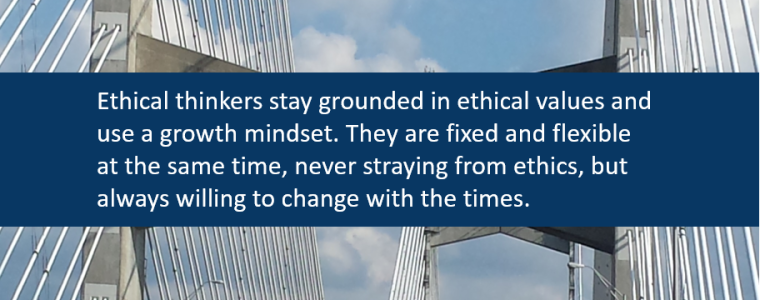By Linda Fisher Thornton Graduates, as you start to search for a job, I want to share some guidance about how to choose an organization that aligns with your values to enhance your work experience and likelihood of success.
Category: Context
What Role Does Exclusion Play in Hate and Violence? Part 2
By Linda Fisher Thornton Moral exclusion includes using an insider mindset and thinking that others (who are not members of the group) as not worthy of protecting. If you're not yet familiar with moral exclusion, this post may be helpful background on differences in world views and selective inclusion.
What Role Does Exclusion Play in Hate and Violence? Part 1
By Linda Fisher Thornton Hate speech and violence do not adhere to ethical values. An ethical person will quickly rule them out due to the harm they cause to others. But even when someone wants to be an ethical person, there are problems with human thinking that can enable hate and violence to happen.
Top Post Series of 2023: Leading in Context Blog
By Linda Fisher Thornton The Top Post Series for last year on the Leading in Context Blog reflected how to navigate the nuances of ethical culture building. It featured specific areas of focus and strategies for building an ethical culture in your organization.
Wishing You Hope
By Linda Fisher Thornton Thank you, friends, for reading and sharing this Blog in 2023. I appreciate all the ways you have helped forward the movement toward authentic ethical leadership. Only by bringing out our best as leaders are we able to bring out the best in those we lead. As we head into this holiday season, I wish you hope. Hope is what keeps us going when problems seem impossible to solve, when time is short, and when solutions are distant. If your hopefulness should ever falter, remember these important words.
Thank Someone Who Changed Your Life
By Linda Fisher Thornton There have been several great leaders who helped me grow, and who inspired me to want to lead others. This message is for them:
How to Tell What’s “Right” in a Complex Situation
By Linda Fisher Thornton To understand a complex situation, you first have to WANT to see it as it really is. This means letting go of preconceived ideas of what might be true, and being open to what may unfold as you learn more. After approaching the situation with this open mindset, you need to get more information. As you know from completing puzzles with lots of pieces, a few pieces do not show you the whole picture. As you complete a jigsaw puzzle, you start to see parts of the picture and begin to get a sense of it, but you're definitely still not seeing it as it really is.
Ethical Thinking and Decision Making for Leaders (Part 6)
By Linda Fisher Thornton This series has explored 5 important leadership spheres of Ethical Thinking and Decision Making. This week I’m summing it up in a checklist that will help you apply all 5 to your daily choices. When you are making a key decision, run it through the checklist to be sure you have considered all 5 important dimensions.
Ethical Thinking and Decision Making for Leaders (Part 5)
By Linda Fisher Thornton While change is a constant reality, it doesn’t always factor into leadership thinking. In Part 1 and Part 2 of this series, I explored the Depth of our thinking, and the importance of understanding Context. In Part 3 and Part 4, I looked at embracing Complexity and the importance of full Inclusion. In Part 5, I’ll describe how embracing Change helps us make ethical decisions.
Ethical Thinking and Decision Making for Leaders (Part 4)
By Linda Fisher Thornton Who we include in our ethical thinking, and how broadly we consider our responsibility to others are both important elements of ethical leadership. In Part 1 of this series, I explored the Depth of our thinking, and in Part 2, I broke down issues related to understanding Context. In Part 3, I looked at embracing Complexity. In Part 4, we’ll dig into the importance of Inclusion.
Ethical Thinking and Decision Making for Leaders (Part 3)
By Linda Fisher Thornton Ethical Thinking and Decision Making require staying grounded in ethical values, but there is much more to do than knowing our values and living them every day through our choices. In Part 1 of this series, I explored the Depth of our thinking, and in Part 2, I broke down issues related to understanding Context. In Part 3, let’s take a look at Complexity.
Ethical Thinking and Decision Making for Leaders (Part 2)
By Linda Fisher Thornton In Part 1 of this series I looked at the importance of Deep Thinking. In Part 2, we’ll consider the Context. No matter how much effort it takes to understand the context, we can’t expect to make an ethical decision without taking that step.
Ethical Thinking and Decision Making for Leaders (Part 1)
By Linda Fisher Thornton Welcome to Part 1 in the series “Ethical Thinking and Decision Making for Leaders.” Welcome to Part 1 in the series “Ethical Thinking and Decision Making for Leaders.” Ethical decision-making is not simply a task. It is the process of analyzing and understanding multiple connected variables in a changing context AND applying ethical values to make responsible choices. It requires doing the work to understand issues clearly before making decisions or taking action. In each post in this series, I’ll explore one aspect of this complex, connected process. Today I’ll focus on the importance of deep thinking.
Ethics and Leadership Should Be Learned Together
By Linda Fisher Thornton Preparing leaders for ethical leadership is a long-term process. It requires careful thought about the messages we are sending. For example, what message are we sending when we separate ethics training from other leadership training?
Ethical Perspectives: Rights, Responsibilities, and Freedom
By Linda Fisher Thornton While some people think of rights, responsibilities and freedom separately, in a compartmentalized way, I believe they cannot be separated, and according to John Courtney Murray, freedom was always intended to be grounded in ethical values.














